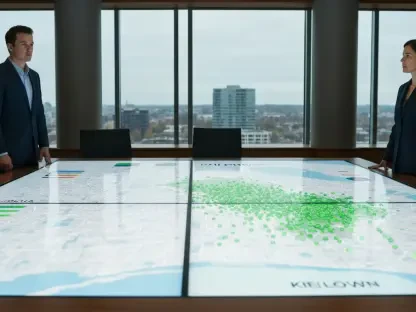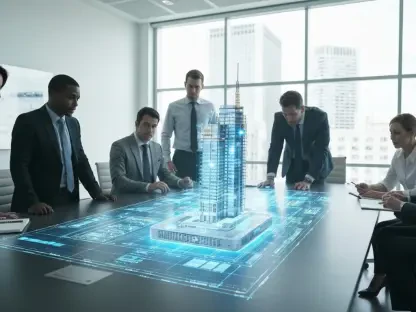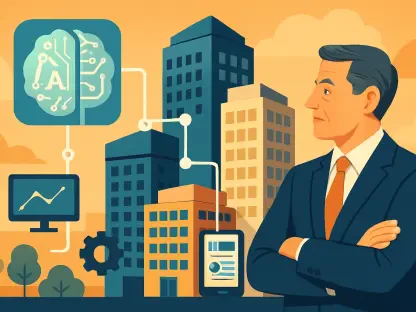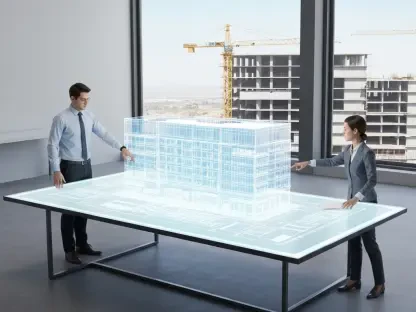As we dive into the future of smart buildings, I’m thrilled to sit down with Luca Calarailli, a renowned expert in construction, design, and architecture, who’s also deeply passionate about integrating cutting-edge technology into the industry. With a wealth of experience, Luca has been at the forefront of exploring how innovations like AI can transform building management and sustainability. Today, we’ll unpack the latest advancements in AI-driven solutions for smart buildings, focusing on energy efficiency, carbon reduction, and the modernization of aging infrastructure. We’ll also explore how these tools empower facility managers and pave the way for a more sustainable future in commercial spaces.
How did the vision for AI-driven solutions in smart buildings come about, and what sparked the push for tools like AI Control and ARIA?
The vision really stemmed from a growing recognition of inefficiencies in commercial buildings. We’ve seen through extensive energy audits that many buildings operate far below their potential—wasting energy and driving up costs. The inspiration was to harness AI to address these gaps, optimizing systems like HVAC to not only save money but also reduce environmental impact. Tools like AI Control and ARIA were born out of a desire to create smarter, more responsive buildings that adapt to real-time conditions and user needs, while also aligning with broader sustainability goals.
What are some of the biggest inefficiencies you’ve noticed in commercial buildings, and how do these new AI tools target those issues?
One major issue is that many buildings don’t adjust to changing conditions like occupancy or weather, leading to unnecessary energy use—think heating or cooling empty spaces. On average, we’ve found about 30% inefficiency in operations. AI Control tackles this by analyzing data dynamically and making real-time adjustments to HVAC systems, ensuring energy isn’t wasted. ARIA, on the other hand, addresses inefficiencies in management by providing actionable insights, helping facility teams prioritize tasks and catch problems before they escalate.
Can you explain the process behind determining that most commercial buildings operate so inefficiently, and what role energy audits played in that discovery?
Absolutely. Over the years, we’ve conducted hundreds of thousands of energy audits across various commercial spaces. These audits involve a deep dive into energy consumption patterns, equipment performance, and building usage. By comparing actual performance against optimal benchmarks, we consistently saw a gap—about 30% inefficiency on average. This wasn’t just a hunch; it’s data-driven insight from real-world assessments that showed us where energy is wasted and highlighted the urgent need for smarter control systems.
How does a solution like AI Control use data such as occupancy and weather forecasts to enhance HVAC performance?
AI Control acts like a brain for the building’s HVAC system. It pulls in data from multiple sources—occupancy sensors, weather predictions, and historical energy usage—and processes it continuously. For instance, if it detects fewer people in the building or forecasts a cool day, it scales back heating or cooling to avoid overuse. It’s all about anticipating needs rather than reacting after the fact, which ensures the system runs at peak efficiency without sacrificing comfort.
Achieving up to 25% savings on heating and cooling costs is a bold claim. What’s the mechanism behind such significant reductions with AI Control?
The savings come from precision and adaptability. Traditional HVAC systems often run on fixed schedules or manual adjustments, which can lead to overworking the equipment. AI Control, however, fine-tunes operations minute by minute based on real-time data. By only using energy when and where it’s needed—say, cooling only occupied zones—it slashes waste. That 25% reduction is a direct result of eliminating inefficiencies that most buildings don’t even realize they have.
You’ve also highlighted a potential 40% reduction in carbon emissions. Can you walk us through how AI Control contributes to this environmental benefit?
Reducing energy consumption directly translates to lower carbon emissions, especially in buildings reliant on fossil fuel-based power. With AI Control optimizing HVAC systems to use less energy—up to 25% less, as we discussed—the carbon footprint shrinks accordingly. Additionally, by ensuring equipment runs only when necessary, we reduce wear and tear, which means less frequent replacements and further environmental savings. That 40% figure reflects the compounded impact of smarter energy use over time.
How seamlessly does AI Control work with existing building systems, and why is it designed to avoid the need for extra equipment or staff?
We designed AI Control to integrate directly into existing architectures like our building automation systems. It’s built to plug into platforms we already have, so there’s no need for costly hardware upgrades or additional staff to manage it. The AI runs in the background, automating adjustments and providing insights without requiring constant human oversight. This approach ensures building owners see benefits from day one without the burden of extra investment or training.
Shifting gears to ARIA, how does this AI-building agent simplify HVAC and facility management for building managers?
ARIA is like having a virtual assistant for facility management. It offers conversational access—think chatting with it on your phone or desktop—to get instant insights and recommendations. Whether it’s identifying a potential HVAC issue or suggesting maintenance priorities, ARIA streamlines decision-making. It takes complex data and translates it into simple, actionable steps, saving managers time and reducing the guesswork in keeping a building running smoothly.
Why was multilingual support a priority for ARIA, and how does offering over 14 languages impact its usability worldwide?
Buildings aren’t managed in a vacuum—they’re global, and so are the teams running them. Including over 14 languages in ARIA ensures that facility managers, no matter where they are or what language they speak, can interact with the tool comfortably. This breaks down barriers, making the technology accessible to diverse users and fostering adoption in international markets. It’s about ensuring everyone can benefit from AI, not just a select few.
Could you share a real-world example of how ARIA might help a building manager diagnose an issue or prioritize maintenance?
Sure, imagine a manager overseeing a large office building. One day, ARIA sends an alert via their mobile app, noting an unusual spike in energy use in a specific zone. Through a quick chat, ARIA pinpoints that an HVAC unit is malfunctioning and suggests checking the air filters first, as data shows they haven’t been replaced in a while. It also flags this as a priority over other routine tasks because of the energy waste. The manager resolves the issue quickly, avoiding bigger costs—all guided by ARIA’s insights.
Both AI Control and ARIA emerged from a dedicated innovation hub. Can you tell us more about the role of such labs in pushing boundaries at your company?
These innovation labs are essentially our sandbox for experimentation and breakthroughs. They bring together experts in AI, digital tech, and building systems to solve real-world problems. The focus is on creating solutions that are not just theoretical but practical and impactful—like AI Control and ARIA. It’s a space where we can test bold ideas, refine them with real data, and ensure they deliver value to customers while aligning with our mission of sustainability.
The concept of ‘next-generation building performance’ has been mentioned. What does that phrase mean to you in the context of building management?
To me, ‘next-generation’ is about buildings that don’t just function but thrive. It means creating spaces that are hyper-efficient, sustainable, and adaptive—buildings that learn and evolve with their environment and occupants. It’s leveraging technology like AI to anticipate needs, minimize waste, and enhance comfort, all while preparing for future challenges like stricter energy regulations or climate goals. It’s a holistic leap forward in how we think about and manage spaces.
With so many U.S. commercial buildings over 25 years old, how do these AI tools help bring outdated systems into the modern era?
A lot of these older buildings run on legacy systems that are energy hogs and tough to maintain. AI tools like AI Control can integrate with existing setups without requiring a full overhaul, optimizing what’s already there. They bring a layer of intelligence to outdated infrastructure, making it perform better without the cost of replacement. ARIA helps too by empowering managers to handle these aging systems more effectively, extending their lifespan while meeting today’s efficiency standards.
The industry is facing a skilled labor shortage. How do these AI solutions support facility managers who are stretched thin?
The labor shortage means many facility managers are wearing multiple hats, often without enough time or expertise to handle everything. AI steps in as a force multiplier. AI Control automates complex tasks like HVAC optimization, reducing the need for manual intervention. ARIA acts as a guide, offering quick diagnostics and prioritizing what needs attention, so managers can focus on critical issues rather than getting bogged down. Together, they ease the workload and enhance human expertise.
Looking ahead, how do you see AI solutions evolving to meet future challenges in building management and sustainability?
I believe AI will become even more predictive and interconnected. We’re moving toward systems that not only react to current conditions but forecast long-term trends—think predicting equipment failures years out or integrating with city-wide energy grids for broader sustainability impact. The focus will also shift to deeper personalization, tailoring building environments to individual occupant preferences while maintaining efficiency. Ultimately, AI will be central to creating buildings that are not just smart, but truly resilient and sustainable in the face of evolving global challenges.









